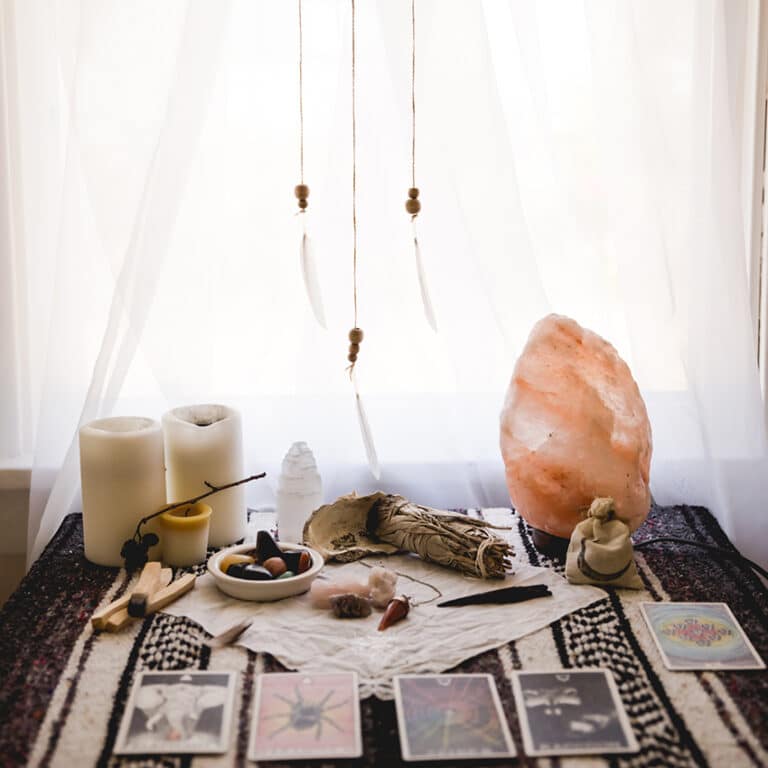The benefits of meditation on our emotional wellbeing and intuitive capabilities have become more popular in recent years, but some of us still have a hard time sitting still with our (lack of) thoughts. If you find yourself getting anxious or restless when attempting to meditate or get into the habit, you’re not alone. You might even think meditation sounds boring. Who wants to sit in silence doing nothing?
But meditation is extremely healing. It can calm the nerves, promote positive thinking, clear negative thoughts, reduce stress, control anxiety, increase attention span, promote kindness and compassion and strengthen self-awareness and confidence, among other benefits. Meditation is all about mindfulness, an activity that improves nearly every aspect of our lives.
Metaphysical tools can help us with so many aspects of our lives, like Astrology, Numerology and Tarot. But many people don’t realize how well these tools work to enhance other practices and rituals, such as meditation. There exists a beautiful, symbiotic relationship between the metaphysical treasures we use – each crystal is associated with an astrological sign, zodiac signs are represented by every Tarot card, Tarot cards have correlating crystals, and so on.
Meditation is an experience that can also be greatly enhanced with the use of these tools, and Tarot cards are a particularly useful medium for promoting peaceful meditation.
Wondering how? Continue reading to find out how tarot is making meditation cooler and more effective than ever.
The Basics of Tarot
To those who are not familiar with Tarot cards, these beautifully illustrated decks can seem intimidating, or even mandated and restricted to use by initiated witches and psychics. While the Tarot has a long-standing association with the occult, the use of Tarot is in no way restricted to or from anyone. Tarot can be useful to anyone who has questions or needs guidance.
While there are some people, typically psychics or mediums, who use Tarot cards to connect with guidance from external sources, be it angels, spirit guides or higher powers, the majority of Tarot-related rituals are carried out by regular people who are seeking guidance from and connection to their own internal well of wisdom.
Many times, the distractions of life can make it difficult to hear our own intuitive voice, and the cards act as bridges between your conscious thoughts and your gut-instincts.
Traditionally, Tarot decks consist of 78 cards – 22 of the Major Arcana and 56 of the Minor Arcana – but these cards come in all shapes, sizes, colors and details. The process of choosing a deck is extremely personal and customizable, as there are thousands to choose from.
There are many ways to read Tarot cards and innumerable resources that explain how to use them in detail. Many decks come with a guidebook that explains each card in detail and suggests different spreads and methods for use. The most important aspect in anything Tarot-related is connecting to your feelings and instincts – the idea is that you will intuitively know which cards to pull and be able to benefit from their meaning and guidance.
Using Tarot Cards in Meditation
If you’re new to Tarot or meditation, the following ideas can help you become acquainted with both tools and encourage you to create your own unique rituals.
A good way to begin the habit of Tarot meditation is by pulling one card a day that seems to be calling to you. Some people like to let their right hand (the “receiving” hand) hover over their deck until they feel warmth or energy from one of the cards. Some people just choose a card at random. The idea is to create your own relationship and traditions with your cards, because the experience is extremely personal. This about connecting to your own internal compass.
Once you’ve chosen your card, look up the meaning of its message. Study its image and associated elements. Try to really take in the sensations that this card provokes and digest the information contained within. Then, take a moment to really meditate on the theme presented to you.
You might sit in silence or with gentle music, contemplating the message and what it means to your life – or you might prefer to write your thoughts and feelings down in a journal. You could even create a piece of art that represents the card of how it makes you feel. The point here is practicing mindfulness and focus.
Because traditional meditation can seem overwhelming to beginners, this process promotes a form of mindfulness and meditation that appeals more to some people and allows them to become more comfortable with the process before diving in fully. It also allows you to get acquainted with your tarot deck in new, exciting ways – even for those who have long worked with the cards.
You don’t have to limit your meditation work to one deck, either. Try spending an hour pulling one card from each of your favorite decks, or you can pull multiple cards from the same deck. You’ll benefit from both the process of mindfulness and focus, as well as the intuition-boosting properties and connection-with-the-self that Tarot promotes.
Concluding Thoughts…
There are so many ways to use the Tarot to increase mindfulness and promote a meditative state, that you can get really creative with the ritual. Try adding incense or a smudged herb to your Tarot-meditation ritual. Light some candles and bring out your favorite crystals.
No matter how you choose to spend time focused on the message and meaning of a Tarot card, you’ll likely find yourself more relaxed, connected to yourself and experiencing more mental clarity in no time.
Related Article: Astrology Answers’ Top 5 Tarot Spreads & How to Use Them
